 Paper Wasps and Yellowjackets - August 22, 2018 Jeff Schalau, Agent, Agriculture & Natural Resources University of Arizona Cooperative Extension, Yavapai County Paper wasps and yellowjackets are beneficial insects. They feed on caterpillars and other insects that could damage crops and ornamental plants in your garden. They also feed on house fly and blow fly larva. Paper wasps and yellowjackets are social insects that become aggressive when their nests are approached or disturbed. This is usually when people and animals are stung. These stings are painful and can be life threatening to allergic individuals. Even so, these insects should be respected and tolerated where they do not pose an imminent threat. Paper wasps have long hind legs and a distinct constriction of the body between the thorax and abdomen. They are common in urban and suburban areas where they can build their papery nests under eaves of structures or in other protected locations. The benefits of wasps usually outweigh potential for harm unless a nest is in a high traffic area such as a doorway or outdoor living area. When approached, paper wasps leave the nest and “dive bombs” intruders with a potential to inflict painful stings. The European paper wasp was introduced to North America in the late 1970’s and has since become established across the U.S. and Canada. They are usually more aggressive than native paper wasps and can be identified by their yellow-orange antennae. European paper wasps are similar to native paper wasps in their nesting/feeding habits and are similarly considered beneficial when not posing a threat to human activity. Yellowjackets forage for a broad range of foods, but they often come into conflict with humans when they are attracted to meat, carbonated beverages, juices, desserts, deceased animals, and other food items. They are commonly a nuisance to outdoor diners during the warmer months. Yellowjackets will often enter cans of sweetened carbonated drinks. Unknowing drinkers can find an agitated yellowjacket in their mouth. This can become serious if an allergic individual is stung in the mouth or throat. Yellowjackets also gather around uncovered trash receptacles where they freely gather food. Both paper wasps and yellowjackets can sting multiple times. The western yellowjacket usually nests in the ground using an abandoned burrow, but can occasionally nest in crawlspaces or wall voids. Underground nests can be disturbed unknowingly by outdoor workers and recreationists. When this happens, the yellowjackets will emerge from the nest and attack the intruder. Underground, the nest is a papery structure that provides a home and breeding area for the queen and contains cells where young are raised. Paper wasps and yellowjackets use a nest for one year although paper wasps may construct a new nest adjacent to an old one. This is important when considering the need for control. Keeping in mind that these insects are beneficial, where the nest is not posing an immediate threat to people or pets, it can be left for the season and removed during the winter months. Some gardeners intentionally attract paper wasps to their gardens by building nest boxes which consist of a wooden box at least 4” x 4” x 4” which open on the bottom. The box is attached to a sturdy post mounted several feet above the ground. Of course, these nest boxes should be in locations where people will not regularly disturb them. Sometimes, paper wasps are too close to high traffic areas and must be removed. Exposed nests can be sprayed with aerosol products labeled for this use. They are usually synthetic pyrethroids which have a quick knockdown effect. These spray insecticides are marketed especially for wasps and yellowjackets and produce a spray stream of up to 20 feet. The nest should be sprayed at night after the wasps have returned from foraging. Do not use a flashlight as they will follow the light beam to its source. Remove and destroy the nest after adult wasps are dead and wash down the nest area with a jet of water to eliminate colony odors. This inhibits surviving wasps from reestablishing a nest in that location. A similar approach can be used on ground nesting yellowjackets. Spray the entrance in the early morning or evening and leave it alone for a few days. There are some aerosol products that produce foam on contact and work well on yellowjacket nests. Traps can also be used when large numbers of yellowjackets are pestering outdoor diners. These traps are available in both reusable and disposable designs. See below for photos and additional resources. Follow the Backyard Gardener on Twitter – use the link on the BYG website. If you have other gardening questions, call the Master Gardener help line in the Camp Verde office at 928-554-8992 or e-mail us at verdevalleymg@gmail.com and be sure to include your name, address and phone number. Find past Backyard Gardener columns or provide feedback at the Backyard Gardener web site: http://cals.arizona.edu/yavapai/anr/hort/byg/. Photos 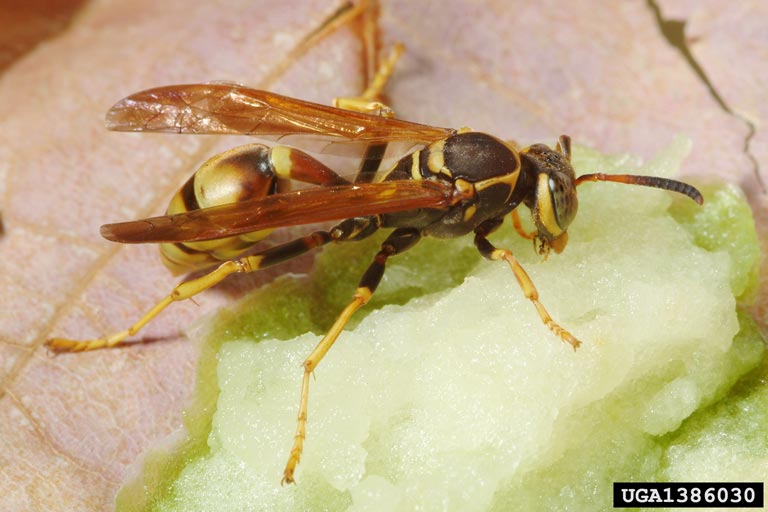 Western paper wasp (Mischocyttarus flavitarsis, Joseph Berger, Bugwood.org).
Western paper wasp (Mischocyttarus flavitarsis, Joseph Berger, Bugwood.org).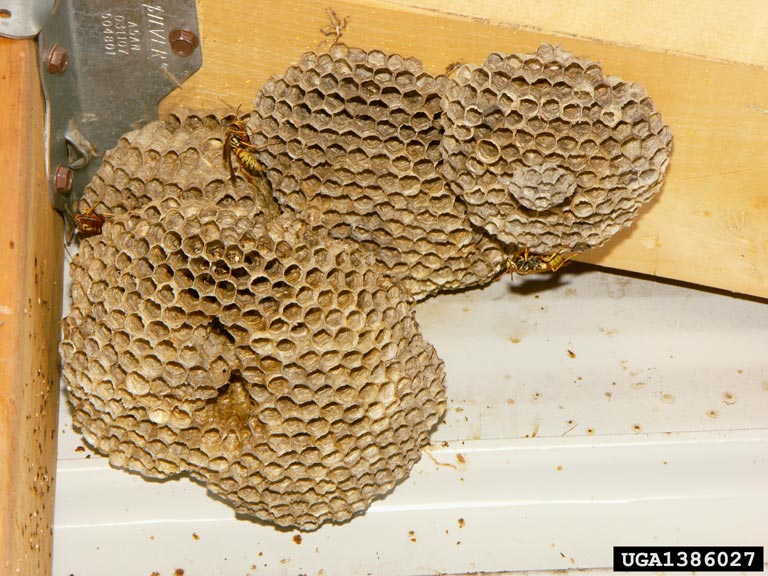 Western paper wasp nest (Mischocyttarus flavitarsis, Joseph Berger, Bugwood.org).
Western paper wasp nest (Mischocyttarus flavitarsis, Joseph Berger, Bugwood.org).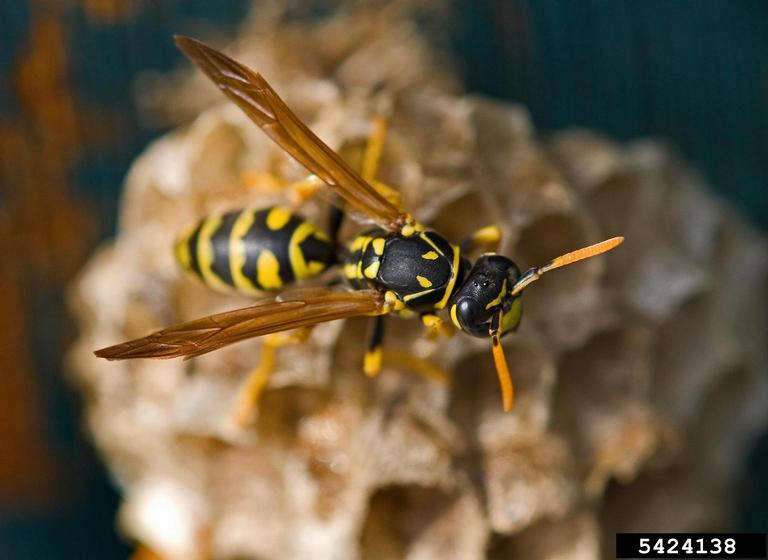 European paper wasp (Polistes dominula, Joseph Berger, Bugwood.org).
European paper wasp (Polistes dominula, Joseph Berger, Bugwood.org).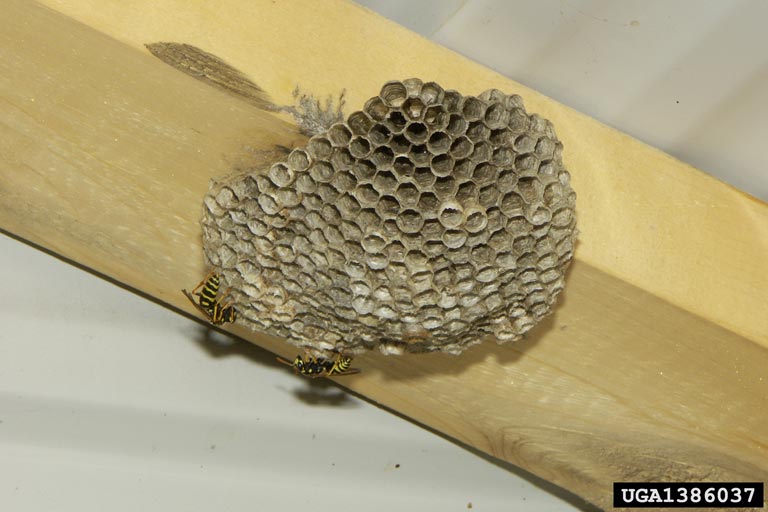 European paper wasp nest (Polistes dominula, David Cappaert, Bugwood.org).
European paper wasp nest (Polistes dominula, David Cappaert, Bugwood.org).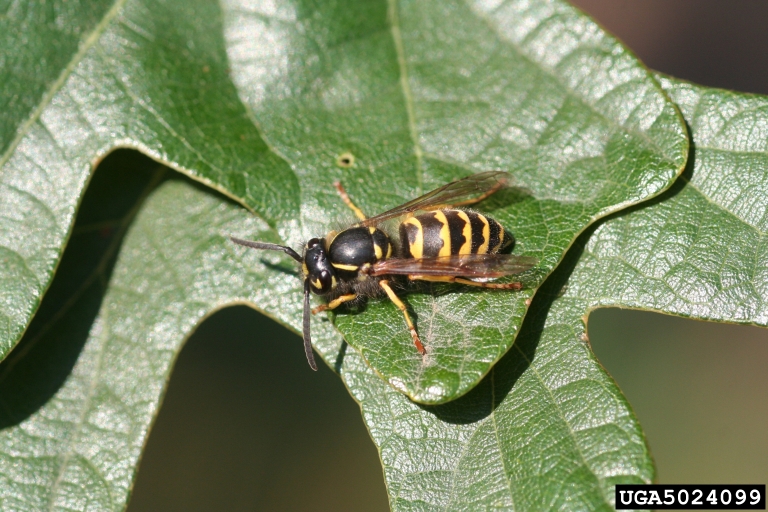 Western yellowjacket (Vespula pennsylvanica, Whitney Cranshaw, Colorado State University, Bugwood.org).
Western yellowjacket (Vespula pennsylvanica, Whitney Cranshaw, Colorado State University, Bugwood.org). Excavated yellowjacket nest (Vespula spp., Jim Baker, North Carolina State University, Bugwood.org).
Excavated yellowjacket nest (Vespula spp., Jim Baker, North Carolina State University, Bugwood.org).Resources Nuisance Wasps and Bees Colorado State University Extension extension.colostate.edu/topic-areas/insects/nuisance-wasps-and-bees-5-525/ European Paper Wasp Colorado State University Extension extension.colostate.edu/topic-areas/insects/european-paper-wasp-5-611/ Homeowners Guide to: Yellowjackets, Bald-Faced Hornets and Paper Wasps Colorado State University Extension extension.uidaho.edu/clearwater/files/2014/11/Homeowner-Guide-to-Yellowjackets-Bald-Faced-Hornets-and-Paper-Wasps.pdf |